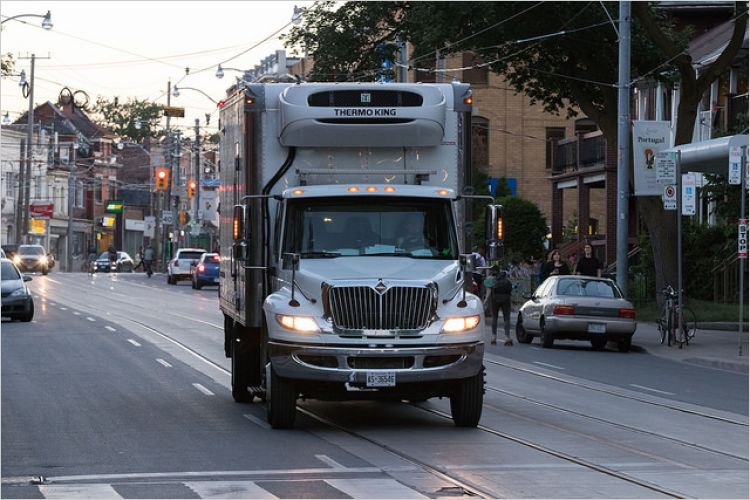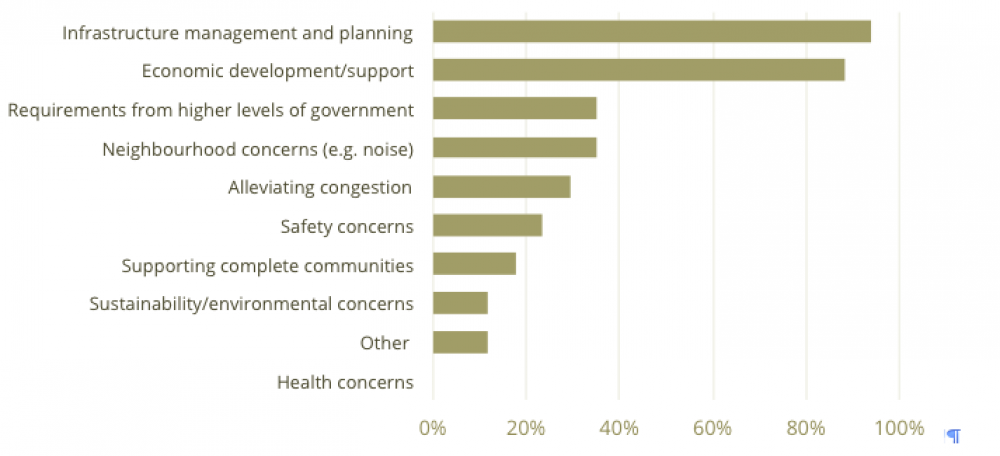
Photo: Rachel Brown for the Pembina Institute
My friend has started buying his toothpaste online. Orders of any size — even two tubes of toothpaste — arrive on his doorstep, delivered by truck, in a day or two. With this kind of convenience, why stop in at the pharmacy on the way home from work?
This kind of online shopping experience is becoming ubiquitous, with plenty of similar services emerging. The volume of goods being shipped is growing swiftly, fueled by rapid economic and population growth: between 1990 and 2014, road freight activity in Ontario grew by 242 per cent. At the same time, trends like online shopping and just-in-time delivery are changing how and where goods move around our cities.
With a growing population and volume of goods moved, congestion is getting worse. Anyone who has driven in a big city can agree it’s not in anyone’s interest for trucks to be stuck in traffic or circling neighbourhoods looking for parking. It’s not in the interest of the climate, either. Emissions from on-road heavy-duty trucks alone are now responsible for just under 10 per cent of Ontario’s emissions, and this is growing: Canada-wide, overall freight emissions (which include trucks, rail, air and marine) are projected to eclipse passenger emissions by 2030. Further, trucks are a leading source of criteria air contaminants linked to respiratory illness and cardiovascular disease.
A role for municipalities: our survey
As our growing communities urbanize and (re-)allocate scarce road space to more sustainable modes of personal travel, we need to think seriously about how goods can move in a compatible way. The shops and workplaces we want to see thrive depend on being able to reliably ship and receive products. In addition to provincial and federal governments, municipal governments have a pivotal — and often overlooked — role to play in finding this balance, given their responsibility to regulate land use, manage road networks, invest in infrastructure, and conduct local climate change planning. For an overview of what municipalities can do to support goods movement, see the Ontario Ministry of Transportation’s Freight Supportive Guidelines.
Are municipalities planning for goods movement in their communities? Why are they? How can they be supported to do more? This summer, our team at the Pembina Institute surveyed 23 Ontario municipalities and conducted interviews and a focus group to find out. Today we published the results in a new report, Local planning for goods movement in Ontario.
Key findings
We found that:
- Policy action is mixed: just over half of respondents reported having freight-related policies in their Official Plans and/or Transportation Master Plans; one has a standalone freight plan. Unsurprisingly, site design and operational measures to address goods movement are more common, at about three quarters of municipalities surveyed.
- Data on goods movement at the local level is extremely limited, presenting a major barrier to policymaking and measurement. Only 13 per cent of surveyed municipalities had conducted a freight audit or study in the last 10 years, and about one-third have or collect data on goods movement.
- Asset management and economic development were identified as the most important factors motivating freight policy adoption. There is an opportunity to link economic, health and sustainability efforts to further build the case for action (see image below).

More regional coordination needed to accelerate progress
Different solutions are needed depending on municipalities’ geographies and local economies. However, our research revealed many immediate areas for action, and most of them boil down to a need for data, resources and coordination.
First, goods movement doesn’t follow city boundaries. We found there is a gap in regional coordination, particularly in the Greater Golden Horseshoe, on data collection and high-level land use/transportation planning. The responsibilities of the Ontario Ministry of Transportation and Metrolinx on freight should be clarified in order to accelerate action.
Coordination within municipalities can also be improved. Municipal staff in economic development, planning, transportation, public health and environment all have a mutual interest in addressing freight, but we heard they rarely collaborate on this front.
For coordinated freight action, municipalities also need to work with industry, and vice versa. Industry’s involvement and commitment to improved planning and efficiency is critical to success. Some municipalities need support identifying and reaching out to major freight players in their communities.
We also heard that freight is usually left out of municipal greenhouse gas (GHG) inventories and climate change plans due to a lack of data and guidance. Standard GHG accounting methodology is needed to measure freight movement to, within and through municipalities. To address resource and expertise gaps, revenue from Ontario’s successful cap and trade program could be allocated to municipalities to support data collection and policymaking on freight.
At about 10 per cent of provincial emissions and growing, we can’t continue to ignore freight as we work to hit our climate change mitigation targets. The great news is that making goods movement more efficient and safe in our cities is in everyone’s interest — from businesses, to commuters, to my friend and his attention to good dental hygiene.
Lindsay was the managing director for transportation and urban solutions for the Pembina Institute until 2019.



